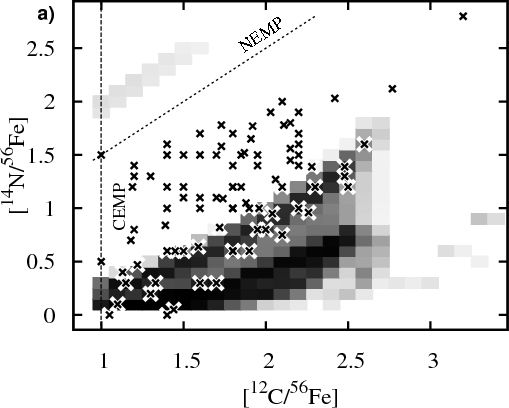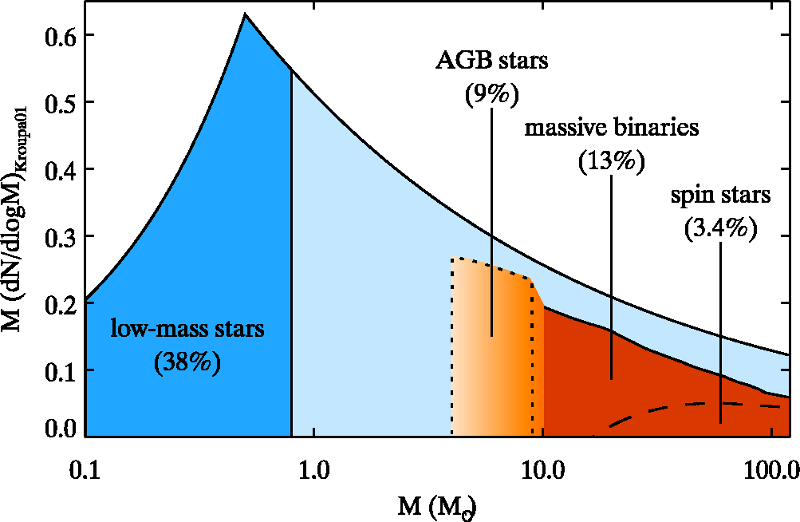| Population Synthesis of Binary Carbon-enhanced Metal-poor Stars |
| R.G. Izzard, E. Glebbeek, R.J. Stancliffe, O.R. Pols |
| The carbon-enhanced metal-poor (CEMP) stars constitute approximately one fifth of the metal-poor ([Fe/H]<-2) population but their origin is not well understood. We discover what physics was at work in low-metallicity AGB stars if they were the creators of the CEMPs. Third dredge up must be very effective in low-mass stars if the Initial Mass Function at low metallicity is the same as in the solar neighbourhood.
|
 |
Nitrogen as a function of carbon in CEMP stars for our model with efficient third dredge up. |
|
| Astronomy and Astrophysics, Volume 508, Issue 3, 2009, pp.1359-1374 |
| Massive binaries as the source of abundance anomalies in globular clusters |
| S.E. de Mink, O.R. Pols, N. Langer, R.G. Izzard |
| The mass budget of the three main Globular Cluster pollution scenarios. |
 |
|
Abundance anomalies observed in globular cluster stars indicate pollution with material processed by hydrogen nuclear burning. We investigate whether massive binary stars could be responsible. Our results show that they could indeed play a role: our binary-star model naturally predicts the ejection of H-burnt material rich in the required sodium and depleted in oxygen.
|
| Astronomy and Astrophysics, Volume 507, Issue 1, 2009, pp.L1-L4 |
| The impact of binary star yields on the spectra of galaxies |
| A.E. Sansom, R.G. Izzard, P. Ocvirk |
|
We make predictions of the effect of binary-star interactions on line strengths in unresolved Galaxies. In most cases the difference induced by duplicity is less than the current observational error, although with new large telescopes the effect of binaries may become important.
|
| Monthly Notices of the Royal Astronomical Society, Volume 399, Issue 2, pp. 1012-1025 |
| A multiphysics and multiscale software environment for modelling astrophysical systems |
| Portegies Zwart, S. et al. |
|
We present MUSE, a software framework for combining existing computational tools for different astrophysical domains into a single multiphysics, multiscale application. MUSE facilitates the coupling of existing codes written in different languages by providing inter-language tools and by specifying an interface between each module and the framework that represents a balance between generality and computational efficiency. This approach allows scientists to use combinations of codes to solve highly coupled problems without the need to write new codes for other domains or significantly alter their existing codes. MUSE currently incorporates the domains of stellar dynamics, stellar evolution and stellar hydrodynamics for studying generalized stellar systems. We have now reached a “Noah’s Ark” milestone, with (at least) two available numerical solvers for each domain. MUSE can treat multiscale and multiphysics systems in which the time- and size-scales are well separated, like simulating the evolution of planetary systems, small stellar associations, dense stellar clusters, galaxies and galactic nuclei. In this paper we describe three examples calculated using MUSE: the merger of two galaxies, the merger of two evolving stars, and a hybrid N-body simulation. In addition, we demonstrate an implementation of MUSE on a distributed computer which may also include special-purpose hardware, such as GRAPEs or GPUs, to accelerate computations. The current MUSE code base is publicly available as open source at http://muse.li.
|
| Proceedings of the MUSE meeting in Split, Croatia. New Astronomy, Volume 14, p.369 |

